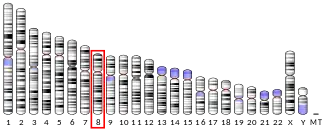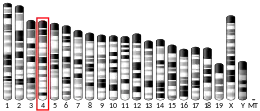| OTUD6B | |||||||||||||||||||||||||||||||||||||||||||||||||||
|---|---|---|---|---|---|---|---|---|---|---|---|---|---|---|---|---|---|---|---|---|---|---|---|---|---|---|---|---|---|---|---|---|---|---|---|---|---|---|---|---|---|---|---|---|---|---|---|---|---|---|---|
| Identifiers | |||||||||||||||||||||||||||||||||||||||||||||||||||
| Aliases | OTUD6B, DUBA-5, DUBA5, CGI-77, OTU domain containing 6B, IDDFSDA, OTU deubiquitinase 6B | ||||||||||||||||||||||||||||||||||||||||||||||||||
| External IDs | OMIM: 612021 MGI: 1919451 HomoloGene: 6064 GeneCards: OTUD6B | ||||||||||||||||||||||||||||||||||||||||||||||||||
| |||||||||||||||||||||||||||||||||||||||||||||||||||
| |||||||||||||||||||||||||||||||||||||||||||||||||||
| |||||||||||||||||||||||||||||||||||||||||||||||||||
| |||||||||||||||||||||||||||||||||||||||||||||||||||
| |||||||||||||||||||||||||||||||||||||||||||||||||||
| Wikidata | |||||||||||||||||||||||||||||||||||||||||||||||||||
| |||||||||||||||||||||||||||||||||||||||||||||||||||
OTU domain containing 6B is a protein that in humans is encoded by the OTUD6B gene.[5]
OTUD6B is a functional deubiquitinating enzyme, a class of protease that specifically cleaves ubiquitin linkages, negating the action of ubiquitin ligases. OTUD6B, also known as DUBA5, belongs to a DUB subfamily characterized by an ovarian tumor domain (OTU).[5] OTUD6B function may be connected to growth and proliferation.[6][7] This hypothesis is supported by a recent study indicating that OTUD6B knock out mice, obtained through exon 4 deletion, are subviable and smaller in size.[8] In humans, OTUD6B mutations have been connected to an intellectual disability syndrome associated with dysmorphic features.[8]
References
- 1 2 3 GRCh38: Ensembl release 89: ENSG00000155100 - Ensembl, May 2017
- 1 2 3 GRCm38: Ensembl release 89: ENSMUSG00000040550 - Ensembl, May 2017
- ↑ "Human PubMed Reference:". National Center for Biotechnology Information, U.S. National Library of Medicine.
- ↑ "Mouse PubMed Reference:". National Center for Biotechnology Information, U.S. National Library of Medicine.
- 1 2 "Entrez Gene: OTU domain containing 6B". Retrieved 2011-08-30.
- ↑ Sobol A, Askonas C, Alani S, Weber MJ, Ananthanarayanan V, Osipo C, Bocchetta M (November 2016). "Deubiquitinase OTUD6B Isoforms are Important Regulators of Growth and Proliferation". Molecular Cancer Research. 15 (2): 117–127. doi:10.1158/1541-7786.MCR-16-0281-T. PMC 5290186. PMID 27864334.
- ↑ Xu Z, Zheng Y, Zhu Y, Kong X, Hu L (January 2011). "Evidence for OTUD-6B participation in B lymphocytes cell cycle after cytokine stimulation". PLOS ONE. 6 (1): e14514. Bibcode:2011PLoSO...614514X. doi:10.1371/journal.pone.0014514. PMC 3022568. PMID 21267069.
- 1 2 Santiago-Sim, Teresa; Burrage, Lindsay C.; Ebstein, Frédéric; Tokita, Mari J.; Miller, Marcus; Bi, Weimin; Braxton, Alicia A.; Rosenfeld, Jill A.; Shahrour, Maher (2017-04-06). "Biallelic Variants in OTUD6B Cause an Intellectual Disability Syndrome Associated with Seizures and Dysmorphic Features". American Journal of Human Genetics. 100 (4): 676–688. doi:10.1016/j.ajhg.2017.03.001. ISSN 1537-6605. PMC 5384096. PMID 28343629.
Further reading
- Xu Z, Zheng Y, Zhu Y, Kong X, Hu L (2011). "Evidence for OTUD-6B participation in B lymphocytes cell cycle after cytokine stimulation". PLOS ONE. 6 (1): e14514. Bibcode:2011PLoSO...614514X. doi:10.1371/journal.pone.0014514. PMC 3022568. PMID 21267069.
- Lai CH, Chou CY, Ch'ang LY, Liu CS, Lin W (May 2000). "Identification of novel human genes evolutionarily conserved in Caenorhabditis elegans by comparative proteomics". Genome Research. 10 (5): 703–13. doi:10.1101/gr.10.5.703. PMC 310876. PMID 10810093.
- Sowa ME, Bennett EJ, Gygi SP, Harper JW (Jul 2009). "Defining the human deubiquitinating enzyme interaction landscape". Cell. 138 (2): 389–403. doi:10.1016/j.cell.2009.04.042. PMC 2716422. PMID 19615732.
This article is issued from Wikipedia. The text is licensed under Creative Commons - Attribution - Sharealike. Additional terms may apply for the media files.



